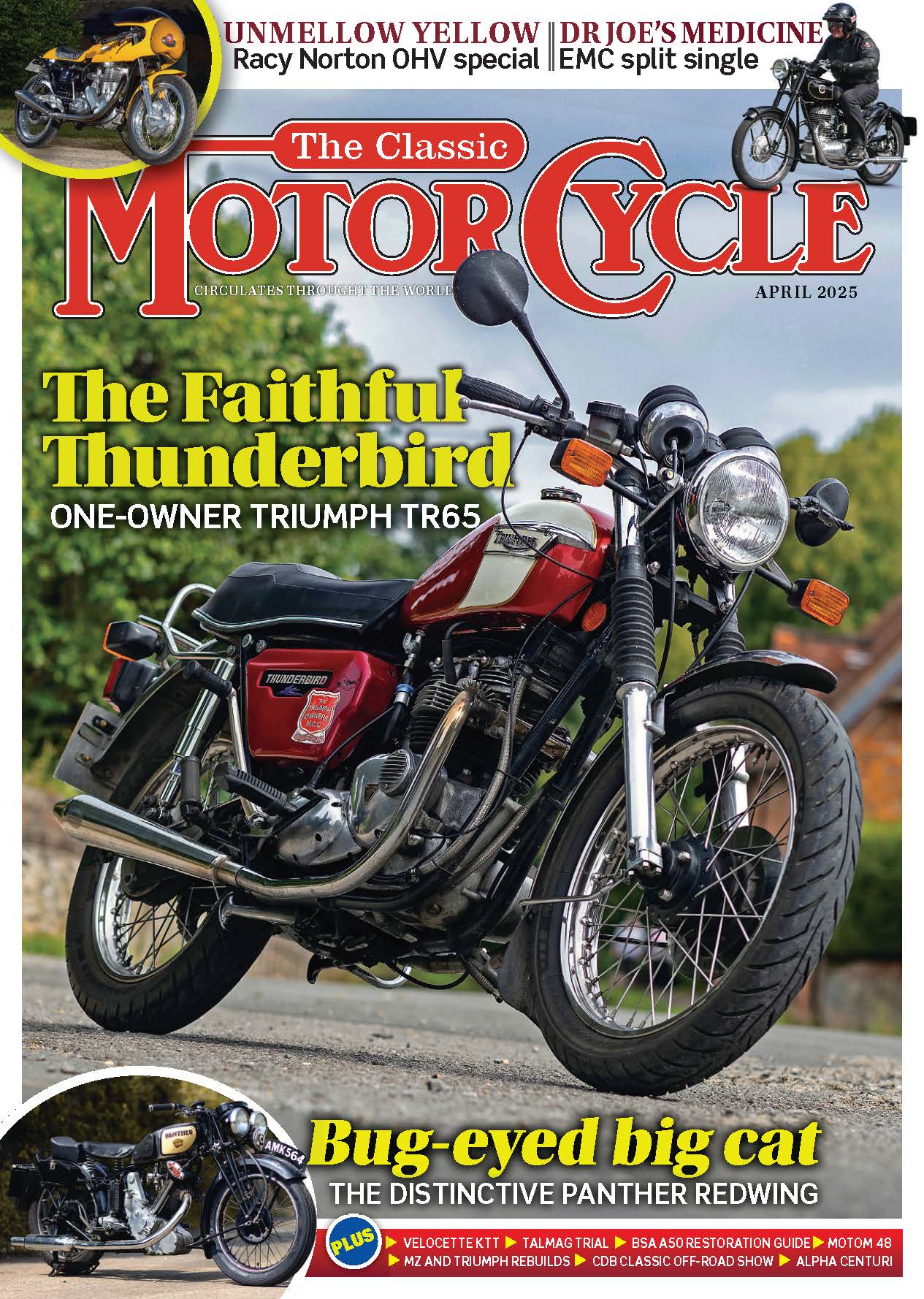
I don’t suppose that the few large side-valve singles still being made in the mid-1950s feature on many Christmas present lists. Such machines had abandoned their sporting pretensions while flappers were still dancing the Charleston; and being unashamedly marketed as sidecar tugs in the age of Rock’n’Roll wasn’t likely to set many pulses racing, was it? But while nobody claims that 600cc Norton Big 4s, BSA M21s and Ariel VBs were balls of fire, surely they wouldn’t have stayed in production for decades if they hadn’t had something going for them. The gutsy solo performance of a Big 4 certainly impressed me, and Arthur Hodgkins – whose Ariel restorations have previously featured in The Classic MotorCycle – offered me the chance to find out whether his newly renovated VB would be as agreeable.
“It doesn’t seem to start very well,” he said, getting his excuses in early, “or at least it doesn’t for me.” Well it makes a nice change from the usual situation where a test machine misbehaves, and its owner plaintively says; “I don’t understand that, it’s usually a first-kick starter.” Fortunately, Murphy’s Law appears to work in reverse, because the VB behaved impeccably for me, starting first or second kick whether hot, cold, or in that troublesome in-between state.
Enjoy more Classic MotorCycle reading in the monthly magazine.
Click here to subscribe & save.
 Well, that’s got the first barrier to affection out of the way, and we can get onto second impressions, where you’ll probably expect me to say that this is a heavy old lump. In fact it is quite a light machine – by 600cc standards – and with a low centre of gravity it feels surprisingly manageable as I take it off its stand.
Well, that’s got the first barrier to affection out of the way, and we can get onto second impressions, where you’ll probably expect me to say that this is a heavy old lump. In fact it is quite a light machine – by 600cc standards – and with a low centre of gravity it feels surprisingly manageable as I take it off its stand.
The stand is under the rear wheel, so it’s admittedly not quite as easy to use as a well-designed centre stand, but its positioning is a reflection of the VB’s genesis before WWII, when punctures where commonplace, and easy rear wheel removal was paramount. Arthur can manage the stand easily enough, despite being of compact build, but he couldn’t resist adding the neat device – where a ratchet spanner handle lowers the stand via an unobtrusive parallel linkage – that he devised for his much lumpier Square Four.
The other main item with an obvious pre-war appearance is the front mudguard, which has wide valances and an extravagant flare at its lower end. It must have been expensive to fabricate, which seems rather at odds with the utility nature of the rest of the bike, but I guess that its effectiveness is exactly what an everyday rider would have wanted. In fact, I don’t have to guess, because this is a well-documented motorcycle, and a previous long-term owner (to whom I’ll return in a moment) added even more exaggerated valances to the rear mudguard.
 I’ll deal with riding first, though, and my favourable impressions continue with the unexpected discovery that the rear suspension actually works! For those not familiar with Ariels, I should perhaps point out that this one relies on the linkage devised in the 1930s by in-house designer Frank Anstey, and while it looks like a plunger set-up, it behaves like a pair of short swinging arms. Unfortunately, it seldom received enough maintenance, so it usually became very stiff, or badly worn, or both!
I’ll deal with riding first, though, and my favourable impressions continue with the unexpected discovery that the rear suspension actually works! For those not familiar with Ariels, I should perhaps point out that this one relies on the linkage devised in the 1930s by in-house designer Frank Anstey, and while it looks like a plunger set-up, it behaves like a pair of short swinging arms. Unfortunately, it seldom received enough maintenance, so it usually became very stiff, or badly worn, or both!
Sure enough, when Arthur shows me the sliders that came on the bike, I can see that their supposedly circular bearing surfaces are distinctly egg-shaped. Luckily he was able to locate some good replacements – and here, as in other parts of the restoration he gratefully acknowledges the help of local Ariel aficionado Tony Peglar – and the result is suspension that I can see moving smoothly up and down as I bounce on an already-sprung saddle.
 More good news comes with the riding position, which is uncompromisingly and logically ‘sit up and beg’ (no right-minded person would make a VB into a café racer, would they?) with Ariel’s pulled back handlebars putting the controls into exactly the right place. Another Ariel characteristic is that the valve lifter is a rotating lever above the advance/retard control, rather than the more usual trigger. It’s easy enough to use (it’s function is stamped into its surface if you forget which is which) but I suspect that it was only specified so that Ariel could demonstrate a little independence from their powerful stablemates at Triumph and BSA.
More good news comes with the riding position, which is uncompromisingly and logically ‘sit up and beg’ (no right-minded person would make a VB into a café racer, would they?) with Ariel’s pulled back handlebars putting the controls into exactly the right place. Another Ariel characteristic is that the valve lifter is a rotating lever above the advance/retard control, rather than the more usual trigger. It’s easy enough to use (it’s function is stamped into its surface if you forget which is which) but I suspect that it was only specified so that Ariel could demonstrate a little independence from their powerful stablemates at Triumph and BSA.
On the transmission side, the VB exhibits another touch of Ariel’s individuality, with its clutch situated in a dry part of the chaincase. As usual, a Burman gearbox is used, and while I’m well aware that no two gearboxes behave in exactly the same way, I have to say that this one’s typically deliberate action seems ideally suited to a side-valve engine that’s not going to change revs very rapidly.
 That leads me nicely to the engine’s performance, and I can already hear you asking, “What performance?” The answer is; “Considerably less than most of us want, but quite sufficient for most of our actual needs.” It’s easy to condemn the 600cc VB because its top speed is no higher than that of a contemporary ohv single with a capacity of a quarter of a litre less, but that’s responding to figures rather than actual experience.
That leads me nicely to the engine’s performance, and I can already hear you asking, “What performance?” The answer is; “Considerably less than most of us want, but quite sufficient for most of our actual needs.” It’s easy to condemn the 600cc VB because its top speed is no higher than that of a contemporary ohv single with a capacity of a quarter of a litre less, but that’s responding to figures rather than actual experience.
Riding behind photographer Joslin’s car between photo locations, I was surprised at how quickly 55mph came up on the speedometer. The engine is so torquey (it wouldn’t have been much good propelling sidecar combinations otherwise) that the sort of speed that’s ample on social runs is achieved and maintained without thought or effort.
Another helpful factor is that the handling is good enough that I don’t even have to think about slowing down for quite sharp bends. And – even better – the engine is remarkably smooth; presumably its restricted rev range made it easy to select a balance factor that avoided a vibration period.
A further bit of good news – which might surprise those unused to side-valve engines – is that the motor emits very little mechanical noise. When you think about it, that’s to be expected with fewer working parts, and the valve gear buried inside the engine instead of sitting on top, but the spin-off from all this is that the engine simply never sounds or feels as if it’s working hard. Naturally that means that the VB isn’t going to suit the kind of person who revels in a bike exhibiting raw power, but if you simply enjoy going places with dignity and little effort, then the VB would suit you to a tee.
 So, it’s a surprisingly agreeable and competent solo motorcycle, but – to return to the reason it was kept in production – what is it like in its primary role as a sidecar tug? Well, I don’t know, but its initial owner – Sam Larkman – certainly did, and he wrote about his experiences in the Cheval de Fer – the Ariel Owner’s Club Magazine.
So, it’s a surprisingly agreeable and competent solo motorcycle, but – to return to the reason it was kept in production – what is it like in its primary role as a sidecar tug? Well, I don’t know, but its initial owner – Sam Larkman – certainly did, and he wrote about his experiences in the Cheval de Fer – the Ariel Owner’s Club Magazine.
Strangely enough, even he rode the VB solo for a while after he purchased it new from Carter and Hartley’s of Plumstead in late-1951. Incidentally, although the Anstey link suspension was listed as a VB buyers’ option, Mr Hartley told Sam Larkman that only export models were actually fitted with it that year, and this one benefited because it arrived too late for a sailor to take delivery.
Every day until he retired, Sam rode the bike to and from his employment as a welder and fitter. And each year, he and his wife toured Britain on their annual holidays, covering between 1500 and 2000 miles each time, visiting – he claimed – every major city, town and seaside between John O’Groats and Lands End. After the first couple of years a Watsonian Ascot sidecar was added to the VB, but its workload didn’t alter, except that in 1955 the Larkmans toured Norway instead of the UK.
By the time the AOC article was written in 1982, Mr and Mrs Larkman were 68 years old and slowing down a bit. But he carried on riding, and when he eventually decided to part with the outfit in 1998, the VB had covered about 255,000 miles, that’s right – more than a quarter of a million miles! Naturally, it had needed some serious attention from time to time, and new big ends had been fitted at approximately 60,000 mile intervals. But Sam claimed that those jobs were the only ones that had required it to be taken off the road, so he was obviously pretty careful both with his maintenance and his driving.
 He was evidently less concerned with appearance, though, and had simply slapped a new layer of paint on the petrol tank every couple of years, and welded up anything that broke, saying; “I never bought anything new that I could repair.” So the outfit was less than pristine when he parted with it a couple of years before his death, and the next couple of owners apparently didn’t make any changes or improvements.
He was evidently less concerned with appearance, though, and had simply slapped a new layer of paint on the petrol tank every couple of years, and welded up anything that broke, saying; “I never bought anything new that I could repair.” So the outfit was less than pristine when he parted with it a couple of years before his death, and the next couple of owners apparently didn’t make any changes or improvements.
As a result, it was, frankly, pretty tatty when Arthur Hodgkins bought it in October 2005, which presented him with a dilemma. Here was a motorcycle with a wealth of history – it even came with documentation – that had been part of a sidecar outfit for more than half a century. And yet it needed serious work just to make it roadworthy, and he had no desire to ride a combination.
Arthur keeps an impeccable journal of his restorations, and he wrote at the time that; ‘A lot of persuasion has been employed by my friends to just tidy the machine up and use it as a runaround, but the more I look at the machine it becomes apparent that there is an awful lot of damage to the tinwear.’ He concluded that; ‘A lot of work is required to make the machine roadworthy and legal – First Aid type work will NOT be enough to satisfy MoT requirements’. Neither would it have satisfied his own exacting standards, and in any case Arthur really prefers workshop activities to riding, so after three months’ deliberation he sold the sidecar, and started on a comprehensive, no-holds barred restoration.
Most restorers are a bit coy about the cost of their work, but Arthur’s meticulous records include absolutely everything, and reveal that he spent nearly £3500 on top of the purchase price. If that takes you aback, then you’ve either never embarked on a total rebuild using outside services, or you’ve been fooling yourself. With painting and plating coming to over a grand, wheel-rebuilding and centre-lining costing over £300, and a replica front mudguard costing over 200 quid, you simply can’t do it for much less. If he was doing it all again, though, Arthur wouldn’t ask a jeweller to re-enamel the little Ariel name strips that are inset into the tank badges – the cost of that was an eye-watering £206!
 Arthur put the VB on the road in March 2008, and in August attended the Ariel Club’s Annual Rally in Bedfordshire, where he duly received a major award. No surprises there, as not only is his post-War VB an excellent restoration, but Ariel fans would recognise its rarity among all the Hunters and Squariels. Conversely, those more glamorous models would have diverted attention from it in the early-1930s, when the VB was introduced as a de Luxe version of the mainstream 557cc Model VA. It must have given Ariel a decent profit margin, though, and in 1936 the VA was dropped, the VB becoming the standard model with its engine’s stroke stretched to give it a full 600cc capacity. Doubtless that was an admission that the days of the big side-valve were over, except in the mundane role of sidecar hauler.
Arthur put the VB on the road in March 2008, and in August attended the Ariel Club’s Annual Rally in Bedfordshire, where he duly received a major award. No surprises there, as not only is his post-War VB an excellent restoration, but Ariel fans would recognise its rarity among all the Hunters and Squariels. Conversely, those more glamorous models would have diverted attention from it in the early-1930s, when the VB was introduced as a de Luxe version of the mainstream 557cc Model VA. It must have given Ariel a decent profit margin, though, and in 1936 the VA was dropped, the VB becoming the standard model with its engine’s stroke stretched to give it a full 600cc capacity. Doubtless that was an admission that the days of the big side-valve were over, except in the mundane role of sidecar hauler.
Well, that continued to be the role allocated to the VB until production ended in 1958, and it remained the function of this particular one for decades after that! However, I bet old Sam Larkman never dreamt that half a century on, his old workhorse would be reborn as a smart and capable solo mount. And whatever your view on the ‘ride or restore’ debate, that’s exactly what it’s become in Arthur Hodgkins’ hands. ![]()
Advert
 Enjoy more The Classic MotorCycle reading in the monthly magazine. Click here to subscribe.
Enjoy more The Classic MotorCycle reading in the monthly magazine. Click here to subscribe.



